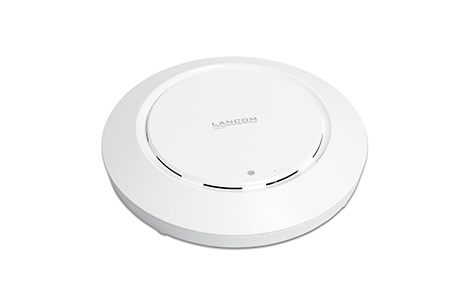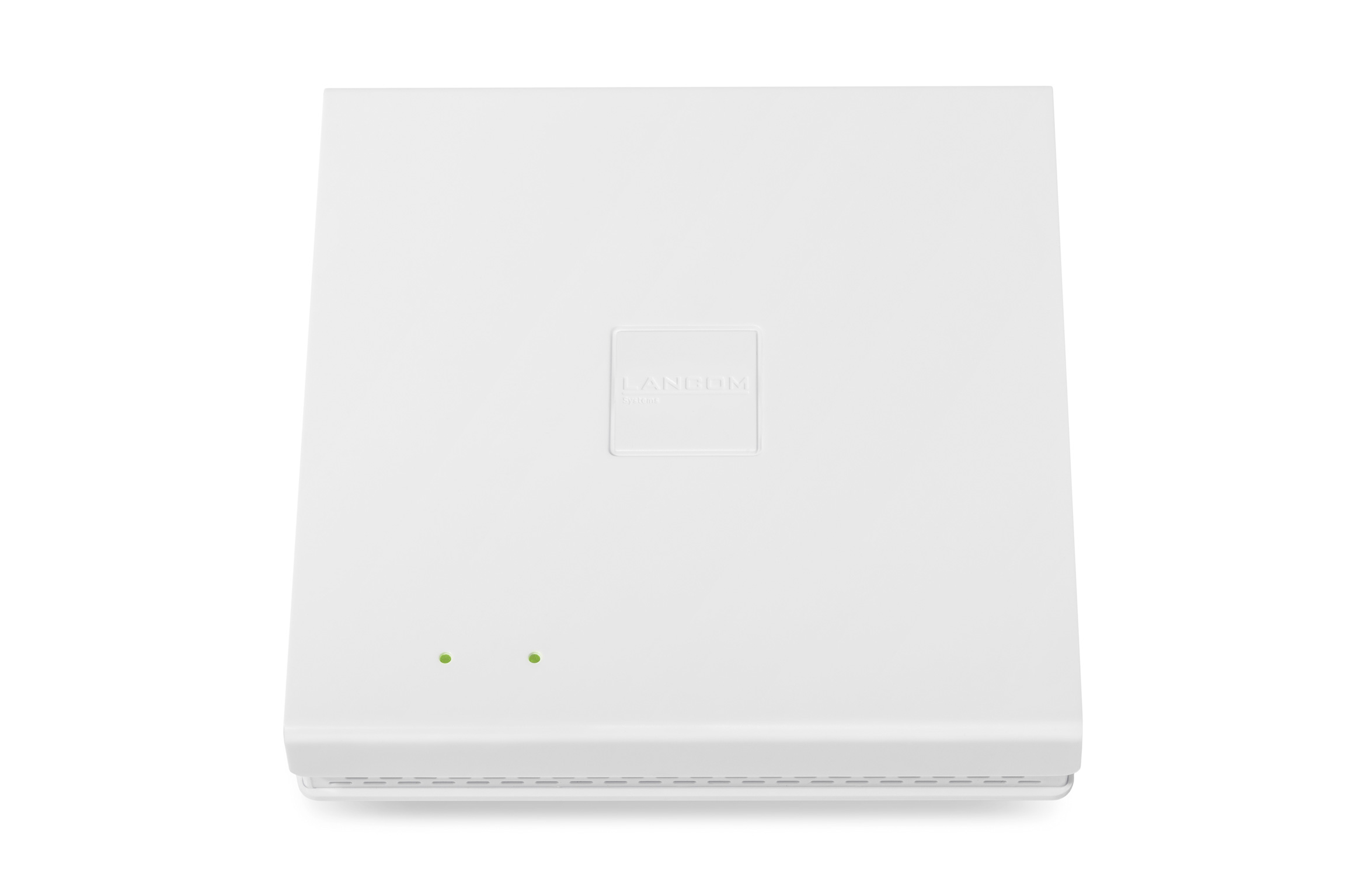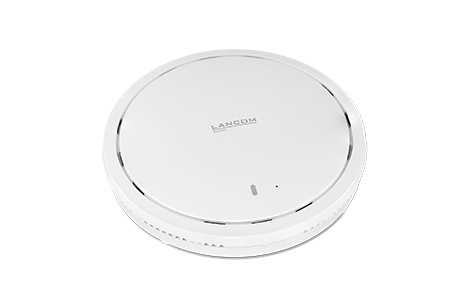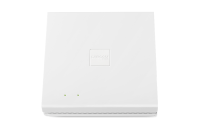Wi-Fi data rates
The data rates supported by access points are based on the use of Modulation and Coding Schemes (MCS). The higher the used MCS, the higher the achievable gross data rate. In net terms, i.e. in practice, clients with higher MCSs can be served with large amounts of data more quickly and thus more clients can be served simultaneously. Use our practical tool to find out which data rates can be achieved depending on the Wi-Fi standard, number of (MU-)MIMO streams, and channel widths.
Overview table Wi-Fi data rates
The following table provides guidance on what data rates can be achieved with the respective Wi-Fi technology. The Wi-Fi data rates are always given as maximum gross values here. Choose one of the following Wi-Fi technologies to see the maximum data rates of our LANCOM access points in the table:
Wi-Fi 5
2 x 2
Wi-Fi 5
4 x 4
Wi-Fi 6
2 x 2
Wi-Fi 6
4 x 4
Wi-Fi 6E
4 x 4
| Datarates table (gross values) | Wi-Fi 4 802.11n (MBit/s) | Wi-Fi 5 802.11ac (MBit/s) | Wi-Fi 6 / 6E 802.11ax (MBit/s) | |
|---|---|---|---|---|
| 4×4 MIMO | 160 MHz | 3,466.7 | 4,803.9 | |
| 80 MHz | 1,733.3 | 2,402.0 | ||
| 40 MHz | 600.0 | 800.0 | 1,147.1 | |
| 20 MHz | 288.9 | 346.7 | 573.5 | |
| 3×3 MIMO | 160 MHz | 2,340.0 | 3,602.9 | |
| 80 MHz | 1,300.0 | 1,801.5 | ||
| 40 MHz | 450.0 | 600.0 | 860.3 | |
| 20 MHz | 216.7 | 288.9 | 430.1 | |
| 2×2 MIMO | 160 MHz | 1,733.3 | 2,402.0 | |
| 80 MHz | 866.7 | 1,201.0 | ||
| 40 MHz | 300.0 | 400.0 | 573.5 | |
| 20 MHz | 144.4 | 173.3 | 286.8 | |
| 1×1 MIMO | 160 MHz | 866.7 | 1,201.0 | |
| 80 MHz | 433.3 | 600.5 | ||
| 40 MHz | 150.0 | 200.0 | 286.8 | |
| 20 MHz | 72.2 | 86.7 | 143.4 | |
| LANCOM Access Points Wi-Fi 5 (2 x 2) | Wi-Fi 4 802.11n (MBit/s) | Wi-Fi 5 802.11ac (MBit/s) | Wi-Fi 6 802.11ax (MBit/s) | |
|---|---|---|---|---|
| 4×4 MIMO | 160 MHz | 3,466.7 | 4,803.9 | |
| 80 MHz | 1,733.3 | 2,402.0 | ||
| 40 MHz | 600.0 | 800.0 | 1,147.1 | |
| 20 MHz | 288.9 | 346.7 | 573.5 | |
| 3×3 MIMO | 160 MHz | 2,340.0 | 3,602.9 | |
| 80 MHz | 1,300.0 | 1,801.5 | ||
| 40 MHz | 450.0 | 600.0 | 860.3 | |
| 20 MHz | 216.7 | 288.9 | 430.1 | |
| 2×2 MIMO | 160 MHz | 1,733.3 | 2,402.0 | |
| 80 MHz | 866.7 | 1,201.0 | ||
| 40 MHz | 300.0 | 400.0 | 573.5 | |
| 20 MHz | 144.4 | 173.3 | 286.8 | |
| 1×1 MIMO | 160 MHz | 866.7 | 1,201.0 | |
| 80 MHz | 433.3 | 600.5 | ||
| 40 MHz | 150.0 | 200.0 | 286.8 | |
| 20 MHz | 72.2 | 86.7 | 143.4 | |
Highest supported data rate:
- 5 GHz operation
- 2,4 GHz operation (40 MHz)
- 2,4 GHz operation (20 MHz)
LANCOM products that
support this data rate:
LANCOM LW-500
LANCOM LN-830U
LANCOM IAP-822
LANCOM OAP-821
LANCOM OAP-822LANCOM LW-500
LANCOM LN-830U
LANCOM IAP-822
LANCOM OAP-821
LANCOM OAP-822
| LANCOM Access Points Wi-Fi 5 (4 x 4) | Wi-Fi 4 802.11n (MBit/s) | Wi-Fi 5 802.11ac (MBit/s) | Wi-Fi 6 802.11ax (MBit/s) | |
|---|---|---|---|---|
| 4×4 MIMO | 160 MHz | 3,466.7 | 4,803.9 | |
| 80 MHz | 1,733.3 | 2,402.0 | ||
| 40 MHz | 600.0 | 800.0 | 1,147.1 | |
| 20 MHz | 288.9 | 346.7 | 573.5 | |
| 3×3 MIMO | 160 MHz | 2,340.0 | 3,602.9 | |
| 80 MHz | 1,300.0 | 1,801.5 | ||
| 40 MHz | 450.0 | 600.0 | 860.3 | |
| 20 MHz | 216.7 | 288.9 | 430.1 | |
| 2×2 MIMO | 160 MHz | 1,733.3 | 2,402.0 | |
| 80 MHz | 866.7 | 1,201.0 | ||
| 40 MHz | 300.0 | 400.0 | 573.5 | |
| 20 MHz | 144.4 | 173.3 | 286.8 | |
| 1×1 MIMO | 160 MHz | 866.7 | 1,201.0 | |
| 80 MHz | 433.3 | 600.5 | ||
| 40 MHz | 150.0 | 200.0 | 286.8 | |
| 20 MHz | 72.2 | 86.7 | 143.4 | |
Highest supported data rate:
- 5 GHz operation
- 2,4 GHz operation (40 MHz)
- 2,4 GHz operation (20 MHz)
LANCOM products that
support this data rate:
LANCOM LN-1700B
LANCOM LN-1702B
LANCOM LN-1700UE
LANCOM OAP-1702BLANCOM LN-1700B
LANCOM LN-1702B
LANCOM LN-1700UE
LANCOM OAP-1702B
| LANCOM Access Points Wi-Fi 6 (2 x 2) | Wi-Fi 4 802.11n (MBit/s) | Wi-Fi 5 802.11ac (MBit/s) | Wi-Fi 6 802.11ax (MBit/s) | |
|---|---|---|---|---|
| 4×4 MIMO | 160 MHz | 3,466.7 | 4,803.9 | |
| 80 MHz | 1,733.3 | 2,402.0 | ||
| 40 MHz | 600.0 | 800.0 | 1,147.1 | |
| 20 MHz | 288.9 | 346.7 | 573.5 | |
| 3×3 MIMO | 160 MHz | 2,340.0 | 3,602.9 | |
| 80 MHz | 1,300.0 | 1,801.5 | ||
| 40 MHz | 450.0 | 600.0 | 860.3 | |
| 20 MHz | 216.7 | 288.9 | 430.1 | |
| 2×2 MIMO | 160 MHz | 1,733.3 | 2,402.0 | |
| 80 MHz | 866.7 | 1,201.0 | ||
| 40 MHz | 300.0 | 400.0 | 573.5 | |
| 20 MHz | 144.4 | 173.3 | 286.8 | |
| 1×1 MIMO | 160 MHz | 866.7 | 1,201.0 | |
| 80 MHz | 433.3 | 600.5 | ||
| 40 MHz | 150.0 | 200.0 | 286.8 | |
| 20 MHz | 72.2 | 86.7 | 143.4 | |
Highest supported data rate:
- 5 GHz operation
- 2,4 GHz operation (40 MHz)
- 2,4 GHz operation (20 MHz)
LANCOM products that
support this data rate:
LANCOM LW-600
LANCOM LX-6200
LANCOM OW-602
| LANCOM Access Points Wi-Fi 6 (4 x 4) | Wi-Fi 4 802.11n (MBit/s) | Wi-Fi 5 802.11ac (MBit/s) | Wi-Fi 6 802.11ax (MBit/s) | |
|---|---|---|---|---|
| 4×4 MIMO | 160 MHz | 3,466.7 | 4,803.9 | |
| 80 MHz | 1,733.3 | 2,402.0 | ||
| 40 MHz | 600.0 | 800.0 | 1,147.1 | |
| 20 MHz | 288.9 | 346.7 | 573.5 | |
| 3×3 MIMO | 160 MHz | 2,340.0 | 3,602.9 | |
| 80 MHz | 1,300.0 | 1,801.5 | ||
| 40 MHz | 450.0 | 600.0 | 860.3 | |
| 20 MHz | 216.7 | 288.9 | 430.1 | |
| 2×2 MIMO | 160 MHz | 1,733.3 | 2,402.0 | |
| 80 MHz | 866.7 | 1,201.0 | ||
| 40 MHz | 300.0 | 400.0 | 573.5 | |
| 20 MHz | 144.4 | 173.3 | 286.8 | |
| 1×1 MIMO | 160 MHz | 866.7 | 1,201.0 | |
| 80 MHz | 433.3 | 600.5 | ||
| 40 MHz | 150.0 | 200.0 | 286.8 | |
| 20 MHz | 72.2 | 86.7 | 143.4 | |
Highest supported data rate:
- 5 GHz operation
- 2,4 GHz operation (40 MHz)
- 2,4 GHz operation (20 MHz)
LANCOM products that
support this data rate:
LANCOM LX-6400
LANCOM LX-6402LANCOM LX-6400
LANCOM LX-6402
| LANCOM Access Points Wi-Fi 6E (4 x 4) | Wi-Fi 4 802.11n (MBit/s) | Wi-Fi 5 802.11ac (MBit/s) | Wi-Fi 6E 802.11ax (MBit/s) | |
|---|---|---|---|---|
| 4×4 MIMO | 160 MHz | 3,466.7 | 4,803.9 | |
| 80 MHz | 1,733.3 | 2,402.0 | ||
| 40 MHz | 600.0 | 800.0 | 1,147.1 | |
| 20 MHz | 288.9 | 346.7 | 573.5 | |
| 3×3 MIMO | 160 MHz | 2,340.0 | 3,602.9 | |
| 80 MHz | 1,300.0 | 1,801.5 | ||
| 40 MHz | 450.0 | 600.0 | 860.3 | |
| 20 MHz | 216.7 | 288.9 | 430.1 | |
| 2×2 MIMO | 160 MHz | 1,733.3 | 2,402.0 | |
| 80 MHz | 866.7 | 1,201.0 | ||
| 40 MHz | 300.0 | 400.0 | 573.5 | |
| 20 MHz | 144.4 | 173.3 | 286.8 | |
| 1×1 MIMO | 160 MHz | 866.7 | 1,201.0 | |
| 80 MHz | 433.3 | 600.5 | ||
| 40 MHz | 150.0 | 200.0 | 286.8 | |
| 20 MHz | 72.2 | 86.7 | 143.4 | |
Highest supported data rate:
- 6 GHz operation
- 5 GHz operation
- 2,4 GHz operation (40 MHz)
- 2,4 GHz operation (20 MHz)
LANCOM products that
support this data rate:
LANCOM LX-6500LANCOM LX-6500
LANCOM LX-6500E
The displayed figures correspond to the defined, maximum gross data rates of the respective Wi-Fi standards. They show the technically maximum data rate with which clients of the respective category can be served. In 2.4 GHz operation, a usable channel width of only 20 MHz rather than 40 MHz should be expected as a realistic operating assumption.
In practice, however, the achievable net throughputs for data transport are significantly lower, since the management traffic of the connection must also be taken into account in addition to the packet header overhead. Also, several access points and clients usually share the transmission time in the air at the same time. In addition, these often compete with other coexistent wireless technologies and systems such as Bluetooth, ZigBee, and DECT in the form of headsets, cameras, telephones, or other audio and video transmission systems, which further reduces the achievable net throughputs.
Note: The use of Wi-Fi 5 data rates (IEEE 802.11ac) is only defined in the 5 GHz frequency band according to the standard. In the 2.4 GHz frequency band, Wi-Fi 5 devices continue to use the backward-compatible Wi-Fi 4 data rates.
Wi-Fi Data Rates and Coverage
Wi-Fi data rates, coverage and interference are all interlinked topics. It’s a simple rule in Wi-Fi that you can’t «have it all». If you use high power, you have big cells and typically more interference. Lower power means more APs are needed. Let’s take a look at these interlinked concepts.
Wi-Fi Speed, Data Rates and Coverage
When we design and assess Wi-Fi networks, we refer to performance in terms of network speed.
For each individual transmission, the sender selects the highest data rate it considers “safe” based on the known information about the environment (SNR history) and the signal strength (last RSSI received).
- A data rate is measured in Mbps (megabits per second)
- Different generations of Wi-Fi have different minimum and maximum data rates and different steps (rates) between them
- 802.11b = 1 — 11 Mbps 802.11a/g = 6 — 54 Mbps
- 802.11n = 7 — 600 Mbps 802.11ac = 7 — 6,933 Mbps
- 802.11ax = 8 — 9,608 Mbps
We determine the coverage of an access point by documenting the SNR and RSSI values when connected to that AP.
A fast wireless network has the following key characteristics:
- Transmissions are sent at high data rates
- SNR is high (above 25)
- RSSI is well above -67 dBm
Utilisation and Interference
Utilisation is a key measure of how “busy” the wireless spectrum is in a particular environment. The higher the utilisation, the more retries, collisions and other errors will naturally occur. We normally count both data traffic and admin traffic as part of assessing utilisation, but we don’t include interference.
Utilisation tracks how close to maximum capacity a network is operating at. We normally rely upon the network to report on utilisation levels, but it’s also possible to collect this in real time from an on-site survey.
As a general rule, 2.4 GHz networks with utilisation above 40-50% are considered “congested” , while 5 GHz networks should not exceed 20-40% to be considered congested.
The threshold is higher for 2.4GHz, because these signals naturally go farther, the admin traffic overhead is much higher.
Interference is closely related to utilisation (as high utilisation can cause interference), but we track it separately.
A transmission is considered interference (or noise) when it gets in the way of a good signal. It may collide, or simply raise the noise floor, which reduces the SNR (see signal strength) and lowers the maximum transmission speed.
Wi-Fi Channels
Digital transmissions use the radio frequency spectrum, which is divided up into logical channels for ease of use and reference.
Wi-Fi channels are 20 MHz wide, but can be bonded in groups of 2, 4, or 8 channels together, using 40, 80 or 160 MHz of spectrum for a single transmission respectively.
Importantly, a 2.4 GHz channel number represents 5 MHz of spectrum, whereas a 5 GHz channel number represents 20 MHz of spectrum. Channel 11 (on 2.4 GHz) is different to channel 36 (on 5 GHz)
There are a few key channel descriptions you should recognise:
- Primary Channel = this channel is always used for administrative transmissions (e.g. Beacons). It is not always the first or lowest channel, but can be any channel in a bonded group.
- Bonded Channel = when multiple channels are used for a single transmission
- Channel Overlap = when two transmissions can use the same part of the spectrum, even if their primary channels differ
ASSOCIATED BLOGS:
Signal Strength and RSSI
A signal is an intended transmission from a source to a receiver. Signal Strength refers to how strong that transmission is received by a receiver.
RSSI (Received Signal Strength Indicator) is the measurement of signal strength from the receiver’s perspective. Most (but not all!) vendors report RSSI as a dBm value.
There are many parallels between sound and radio signals, including some of the characteristics of attenuation and measuring approaches.
We often use the following terms when we are discussing signal strength:
- Attenuation = the passive reduction in signal strength between transmitter and receiver
- Bleed = Signals that extend beyond the range of desirable coverage (e.g. between floors, or beyond external walls)
- dBi= stands for dB(isotropic). This is the forward gain of the antenna, measured in dBi. Forward gain is measured against a hypothetical isotropic antenna. Essentially this is antenna gain.
- dBm = a way of calculating the strength of signals and noise. Decibels are a logarithmic measure of RF power.
- EIRP = the legal allowable limit on how much energy can be transmitted
- mW = Milli-Watts are another way of representing RF power — this time on a standard, non-logarithmic scale.
- Power Level = a vendor-specific measure of signal strength, often in a range of 1 — 8
- SNR = Signal-to-Noise ratio = the difference between transmission strength and active sources of RF (see interference)
ASSOCIATED BLOGS:
Wi-Fi Data Rates and Coverage: Summary
In Wi-Fi, there is a common rule that any changes you make will affect the primary thing you’re trying to change (transmit speed, coverage, etc), but there is often a secondary component to this too.
Increasing data rates reduces cell sizes. Increasing transmit power increases cell size — but might increase cell overlap and interference too.
The challenge is to understand how these variables compete and complement — and once done, you can build and tune your wireless network.
Hopefully this blog has been of use in getting the thinking started on how different capabilities of a Wi-Fi network fit together.
As ever, if you need support with your design and install, drop us a line at sales@iptel.com.au







%202-1-Jan-06-2022-07-34-35-55-AM-Jan-06-2022-07-35-34-80-AM.png?width=97&height=97&name=Wi-Fi%20Predictive%20Design%20(Instagram)%202-1-Jan-06-2022-07-34-35-55-AM-Jan-06-2022-07-35-34-80-AM.png)